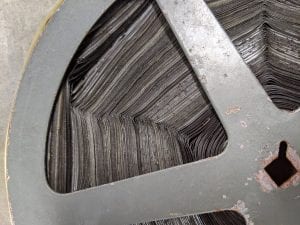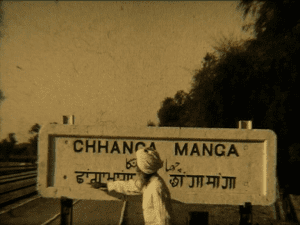Digitising the British Empire & Commonwealth film collection
Posted on by Lauren MacCarthy.
by Jayne Pucknell, Archivist
The digitising of some of our most important or unusual films from the British Empire and Commonwealth film collection started in July 2019, and will run to autumn 2020.
We have around 2,000 films in the British Empire and Commonwealth Collection. Many of our films have been digitised but not to the archival standards needed in order to preserve this footage digitally for future generations. Recently we decided to digitise some of our most important or unusual films. The film digitisation project started in July 2019, and will run to autumn 2020. We are working with Nulight Studios, a Bristol-based company, who won the contract for this work.
The collection contains amateur footage from many countries. Most were taken by white British people living and working in parts of the former empire and Commonwealth. We have two main reasons for digitising these films.

Film badly affected by vinegar syndrome.
Firstly, most of this footage was taken using cellulose acetate film which can gradually degrade over time. The film base develops what is called ‘vinegar syndrome’ named for the distinctive smell of acetic acid that it gives off. The footage eventually becomes brittle and unusable. Fortunately only a small percentage of our films have been affected so far. Once affected, the damage cannot be repaired.
The recommended practice is to digitise films to archival preservation standards, then freeze the original footage to halt any future deterioration. Freezers have lots of uses! During digitisation, each frame is carefully scanned by Nulight in order to capture as much detail as possible from the original.
Secondly, we want to enable access to more of our amazing films. Once digitised and catalogued, we make footage available in our public searchroom at Bristol Archives. Our long-term plan is to share the footage online.
So what films have gone through Nulight’s scanner so far? Here are a few examples.
- Our earliest footage dates from 1920. It records the riots which erupted during the Nebi Musa festival in Jerusalem (ref 2008/059). 250 people were injured and nine people died as a result of the violence. Michael Higgins, who acquired these two minutes of rare footage, later became a member of the Palestine Police Force.
- In films taken by Charles Keddie, along with other scenes in Egypt, we can see a ghostly zeppelin flying over the pyramids in 1931 (ref 2002/076). Keddie worked as Chief Photographer for the Survey Department of the Colonial Government. He was also a keen desert motorist. In 1926 Keddie drove all the way from Cairo to Leith, Scotland, with his wife, in a 7HP Jowett motor car!

Changa Manga railway station, from footage taken from the Owen Williams film collection (ref 2008/078/003).
- Films captured by an engineer, Owen Williams, record the process of logging and preparing sleepers for the Indian railway in the 1930s (ref 2008/078). His collection includes great footage of the railway station at Changa Manga (now in Pakistan). It shows people waiting on the platform as the steam train arrives.
- We have colourful footage of 1960s Nairobi, taken on the cusp of independence by Anthony Rees (ref 2001/047). Rees was an education officer working in Kenya. He gives us some great views of the buildings and streets in the city. Some are decorated for the independence celebrations of December 1963.
We’re going to be sharing some clips from the film archives each month on Twitter – look out for them! And if you want to find out more about the film collection, you can contact us at [email protected].